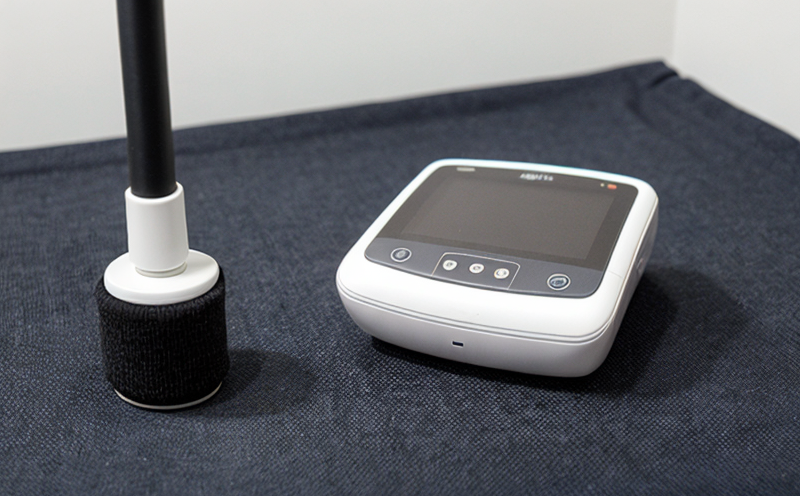BS EN ISO 105-X12 Colour transfer in printed smart fabrics
The BS EN ISO 105-X12 standard addresses the issue of colour transfer from printed textiles onto adjacent materials, a critical concern for smart and functional textiles. These textiles incorporate electronic or other components that can be adversely affected by the transfer of dyes or pigments. This testing ensures that the aesthetics and functionality of the textile remain intact throughout its lifecycle.
The standard is particularly relevant in sectors like healthcare, automotive, and fashion where printed patterns are used on textiles for both aesthetic and practical purposes. For instance, in healthcare, printed textiles are often used as coverings or accessories. In automotive interiors, printed fabrics can enhance visibility through contrast while also providing a pleasant visual experience.
The testing procedure involves placing the sample under specific conditions to simulate real-world usage scenarios, such as rubbing, washing, and exposure to light. The specimen is then compared against reference materials to assess any colour transfer that might have occurred. This ensures that the printed pattern on smart textiles maintains its integrity even after being subjected to various environmental factors.
The process of preparing specimens for BS EN ISO 105-X12 involves careful selection and handling to avoid altering the properties of the textile. Specimens are cut according to predefined dimensions, ensuring consistency across samples. The test setup simulates realistic conditions, such as rubbing against a specified fabric or being exposed to light sources with defined spectra.
The instrumentation used in this testing is highly specialized, often involving spectrophotometers and other colorimeters that can accurately measure the colour change before and after the transfer process. These tools are essential for capturing minute differences in colour intensity and hue, providing precise data for analysis.
The acceptance criteria for BS EN ISO 105-X12 are stringent to ensure that only textiles meeting the highest standards of quality pass this test. Any measurable colour transfer is noted, and the extent of such transfer determines whether the textile meets the standard requirements. This level of detail ensures that smart textiles remain functional and aesthetically pleasing throughout their intended use.
Understanding the implications of colour transfer in printed smart fabrics is crucial for various stakeholders involved in the development and manufacturing process. For quality managers, ensuring compliance with this standard can enhance product reliability and customer satisfaction. Compliance officers need to stay updated on these standards to maintain regulatory compliance, while R&D engineers can use this information to innovate and improve textile designs.
For procurement teams, understanding the impact of colour transfer helps in selecting suppliers who adhere to such high standards. By integrating BS EN ISO 105-X12 into their quality control processes, organizations ensure that they deliver products that meet both functional and aesthetic expectations.
Applied Standards
| Standard Reference | Description |
|---|---|
| BS EN ISO 105-X12 | Specification for the determination of colour transfer from printed textiles onto adjacent materials. |
| ISO 10309-6 | Reference values for the measurement and specification of colours used in textile printing. |
| ASTM D7458 | Standard test method for determining colour transfer resistance to rubbing of printed textiles using a standard abradant. |
| EN 12368-2 | Reference values and methods for the measurement of lightfastness on textile fabrics. |
The BS EN ISO 105-X12 standard, alongside other referenced standards like ASTM D7458 and EN 12368-2, provides a comprehensive framework for evaluating colour transfer resistance. These standards ensure that the testing process is consistent and reliable, producing accurate results that can be relied upon by stakeholders in the textile industry.
Customer Impact and Satisfaction
The implementation of BS EN ISO 105-X12 ensures that customers receive textiles with consistent colour fidelity and excellent durability. This standard helps in maintaining the aesthetic appeal and functionality of printed smart fabrics, which is crucial for customer satisfaction.
By adhering to this standard, manufacturers can guarantee that their products will retain their original appearance and performance over time. This not only enhances brand reputation but also builds trust with customers who value quality and reliability.
In the healthcare sector, where printed textiles are used in patient care environments, ensuring colour transfer resistance is vital for maintaining a professional image and enhancing the overall experience of patients and staff. In automotive interiors, smart textiles that withstand colour transfer can provide a more consistent visual experience, contributing to passenger comfort and safety.
For fashion brands, meeting this standard allows them to offer products that are not only stylish but also durable, appealing to consumers who value long-lasting garments. This aligns with the growing trend of sustainable fashion, where durability is an essential attribute.
Competitive Advantage and Market Impact
The adoption of BS EN ISO 105-X12 can provide a significant competitive advantage by setting benchmarks for quality and durability in printed smart textiles. This standard ensures that products meet the highest industry standards, which is increasingly important as consumer expectations rise.
Manufacturers who comply with this standard can differentiate their offerings from competitors by offering superior quality and reliability. This differentiation can lead to increased market share and customer loyalty, as satisfied customers are more likely to recommend and repurchase products.
In the healthcare sector, compliance with this standard can enhance the reputation of medical device manufacturers and suppliers, contributing to a positive perception among healthcare providers and patients. In automotive interiors, meeting these standards can elevate brand image and appeal to environmentally conscious consumers.
The market impact of adhering to BS EN ISO 105-X12 extends beyond individual companies to influence industry trends. As more manufacturers adopt this standard, the overall quality and durability of smart textiles improve, setting new benchmarks for the entire sector. This can lead to innovation in textile design and manufacturing processes, driving further advancements in technology and sustainability.





